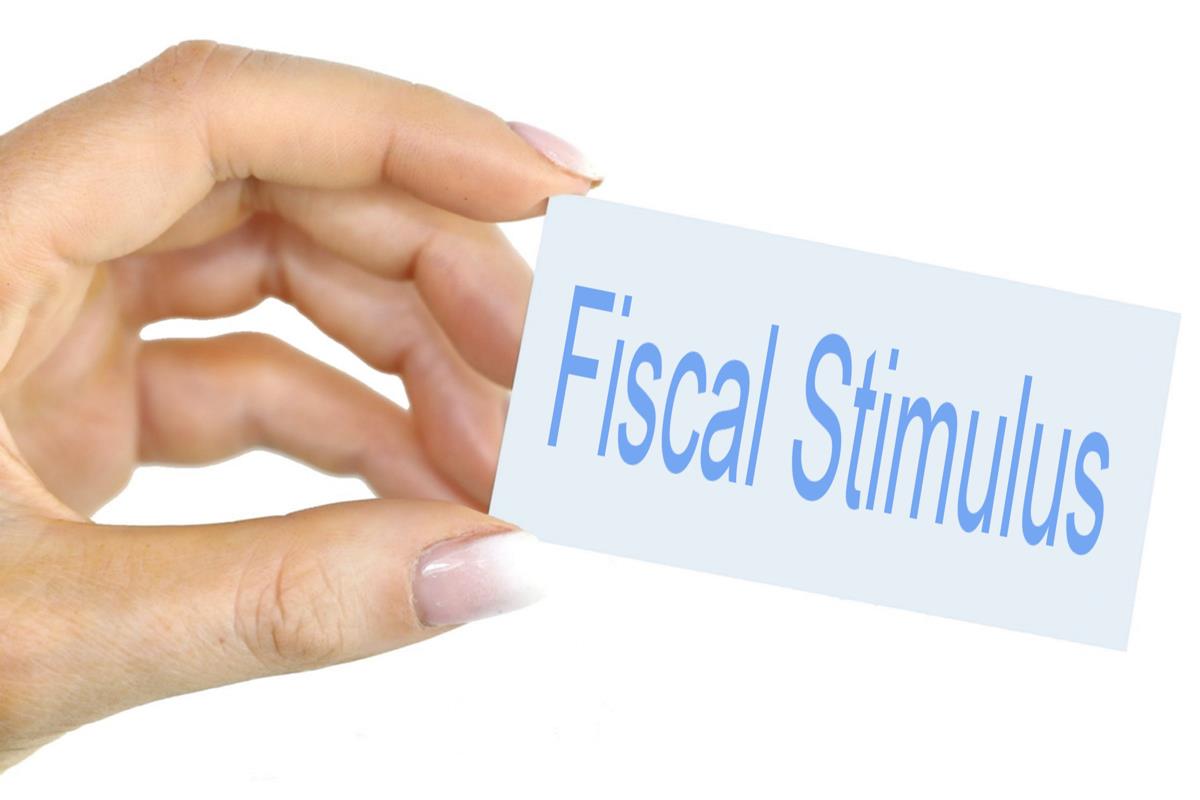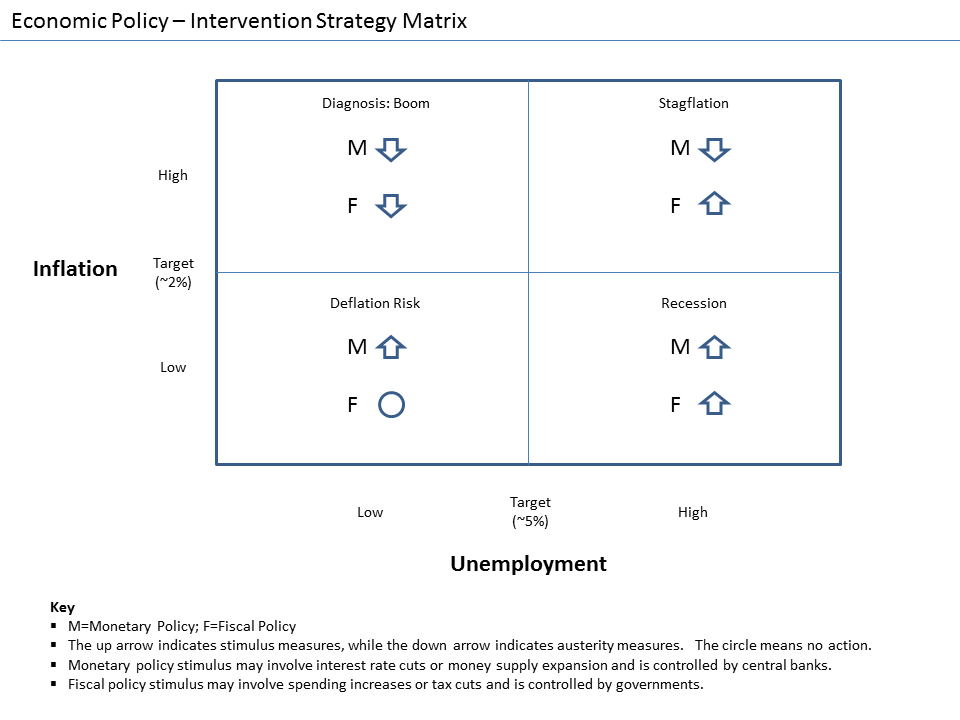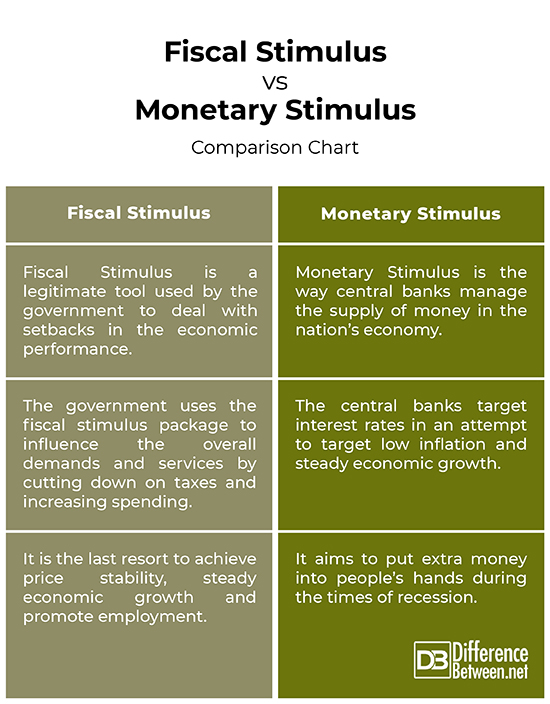Difference Between Fiscal Stimulus and Monetary Stimulus
The concerns following the financial crisis are nothing new. When the financial market tumbles, this has a significant impact on the economy. During times of economic crises, the operations of financial institutions have often been reshaped – for example, the panic of 1907 led to the foundation of the Federal Reserve System or the regulation of United States banking in the aftermath of bank failures during the Great Depression in the early 1930s. Economic slowdown is defined as periods which entail negative growth rate or when standard deviation drops below zero. During periods of economic slowdown, the government and the central bank can try to jumpstart the economy using two main tools at their disposal – the fiscal stimulus and the monetary stimulus.

What is Fiscal Stimulus?
Fiscal Stimulus is a legitimate tool used by the government to deal with setbacks in the economic performance. The economy does not always perform at its potential. When the actual output falls below potential, a certain situation arises which the economists call a recessionary gap. Factories go out of business and workers go unemployed. Sometimes, actual output briefly rises above its potential. This is what economists call an inflationary gap. Workers work over time and unemployment is inevitable, which is not sustainable. Real life implications are not as predictable as they seem. To deal with such downturns, policy makers should intervene to reduce inflation. One of the ways to do it is fiscal policy. The idea of fiscal stimulus is simple; when the economy tumbles, the government can step in by changing government spending or taxes in order to revive the economy. It increases output and incomes in the short run which in turn increases the demand for goods and services, eventually lessening the burden of the recession and boosting growth.

What is Monetary Stimulus?
Monetary Stimulus is basically the way central banks manage the supply of money in the nation’s economy. This means the government tries to regulate the amount of money in circulation by increasing the amount of money in the nation’s economy and decreasing the cost of accessing it. So, the central bank creates money but it does not actually print the money. It increases the amount of money it has electronically. Typically, this can be achieved by one of two ways. The first way is to reduce the market interest rates which will encourage businesses to invest as borrowing becomes cheaper, which in turn helps boost the economy. Next thing is the money supply; what they can do is increase the money supply by simply injecting extra cash into the economy. For example, they buy bonds from banks which eventually increase the amount of money they have in cash, which will make money cheaper encouraging banks to lend it to businesses and consumers.
Difference between Fiscal Stimulus and Monetary Stimulus
Control
– While both fiscal stimulus and monetary stimulus are measures to revive the tumbling economy during times of economic slowdown, they are two different tools with different implications and effects but probably the same outcome. Fiscal stimulus is a government-controlled measure that involves changing government spending and taxation levels in order to jumpstart the economy. Monetary stimulus, on the other hand, is controlled by central banks authorities who try to target low inflation and steady economic growth by increasing the amount of money in nation’s economy.
Model
– Fiscal stimulus model is a means to adjust the government’s spending levels and tax rates to influence the economy. The government uses the fiscal stimulus package to influence the overall demands and services by cutting down on taxes and increasing spending, minimizing the burden of recession and boosting economic growth. Monetary stimulus is basically a policy model used by central banks to manage the supply of money. In the United States, the Federal Reserve plays the role of the central bank. The primary tool of monetary stimulus is interest rates.
Working
– Fiscal stimulus can be carried out by the government through direct spending. Typically, the government increases spending and its hiring process to promote employment and growth. This creates an injection of money directly into the nation’s economy. The spending goes up and the companies need the workforce to deal with increasing demand, eventually contributing back to the economy. Monetary stimulus works in one of two ways. The first way is to reduce the market interest rates which will encourage businesses to invest, and the next is to increase the money supply by simply injecting extra cash into the economy.
Fiscal Stimulus vs. Monetary Stimulus: Comparison Chart

Summary of Fiscal Stimulus and Monetary Stimulus
Both fiscal and monetary stimulus policies are the necessary measures that attract global capital inflows during economic downturns and recoveries. They influence wages, employment, inflation, interest rates, and exchange rates, but their policy implications are fundamentally different. In the Keynesian paradigm, monetary policy is an effective tool for macroeconomic stabilization that aims to attain higher GDP growth and promote full employment. Fiscal stimulus works to adjust the government’s spending levels and tax rates to influence the economy. It increases output and incomes in the short run which in turn increases the demand for goods and services, eventually lessening the burden of the recession.
- Difference Between Caucus and Primary - June 18, 2024
- Difference Between PPO and POS - May 30, 2024
- Difference Between RFID and NFC - May 28, 2024
Search DifferenceBetween.net :
Leave a Response
References :
[0]Leigh, Daniel and Sven Jari Stehn. Fiscal and Monetary Policy During Downturns: Evidence From the G7. Washington, D.C., United States: International Monetary Fund, 2009. Print
[1]Hubbard, Glenn R. Financial Markets and Financial Crises. Illinois, United States: University of Chicago Press, 1991. Print
[2]Heim, John J. Crowding Out Fiscal Stimulus: Testing the Effectiveness of US Government Stimulus Programs. Berlin, Germany: Springer, 2016. Print
[3]Pettinger, Tejvan. Cracking Economics. London, United Kingdom: Hachette UK, 2017. Print
[4]Langdana, Farrokh. Macroeconomic Policy: Demystifying Monetary and Fiscal Policy. Berlin, Germany: Springer, 2002. Print
[5]Image credit: https://upload.wikimedia.org/wikipedia/commons/a/a7/Economic_Policy_-_Intervention_Strategy_Matrix.png
[6]Image credit: https://www.thebluediamondgallery.com/hand-held-card/images/fiscal-stimulus.jpg
